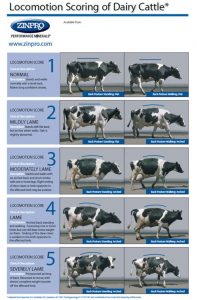Bovine Lameness and Podiatry
Bovine Lameness
Lameness is a significant cause of economic loss in cattle and is often a herd problem. Bovine lameness is heavily underdiagnosed. In the Midwest, the level of lameness in cattle is 13-16%. Herdsmen recognize less than 1/2 of the cases.
Indications of lameness
Indicators of lameness in cattle are similar to those in horses but are evaluated at a walk. One of the most common findings is an arched back. Head weaving, head nods, changes in length of stride, limb deviation (abduction, adduction), limb asymmetries, pressure sores and weight shifts can also be identified. Cattle should be watched from a distance and when rising from a recumbent position.
- Cattle normally rise to a standing position by getting to their knees, then lifting their hindquarters and finally rising on the forelimbs. Changes from this pattern typically indicate pain in the phase that is out of turn (eg trying to rise from knees to directly standing up on the forelimbs would indicate back or hindlimb issues).
- Head weaving (head moving side to side) is seen with milder lameness cases and is another way to shift weight
- Pressure sores are usually identified on the good side as the animal has a difficult time rising when the bad limb is uppermost.
- Hygromas are nonpainful swellings (false bursas) that arise to protect the underlying tissues that are being repeatedly traumatized. Hygromas are not a cause of lameness but can indicate chronic changes in weight bearing or environmental problems as they arise
- If the limb is bearing more weight, the fetlock will sink more. This is the good limb.
- The medial digit bears the majority of weight in the forelimb while the lateral digit bears the majority of weight in the hindlimb. Cattle will stand base wide or with crossed forelimbs to adjust weight away from an injured digit.
- Most lameness issues are in the hindlimb lateral digit; this is likely related to the limited ability to shift weight off that limb (hip joint structure)
Locomotion scoring of dairy cattle

AI may be able to help with early lameness detection:
Automated dairy cattle lameness detection utilizing the power of artificial intelligence; current status quo and future research opportunities
Environmental Evaluation
It can be useful to think of lameness as a herd outbreak and evaluate the environment and other predisposing factors. Treating the individual animal is often still necessary but is generally the tip of the iceberg.
While foot rot and digital dermatitis are infectious in origin, most conditions are related to forms of hoof trauma. The major factors involved with lameness in cattle are flooring surfaces, management protocols and diet.
Regular hoof trimming programs help prevent hoof overgrowth and associated foot lesions. Regular trims also promote healthier hoof growth.
Low BCS (<2.5) is associated with more foot issues (sole ulcers, white line disease), more issues due to recumbency and likely less success in competing for food. If cattle are less able to get to the trough, this could create a vicious cycle in maintaining a low BCS.
Larger herds tend to be better managed but individual members less observed. While the overall health of the herd may be better, it can be easier for individual cow issues to be missed.
Wet environments, abrasive surfaces and skin irritation from chemicals or manure can predispose animals to opportunistic infections, particularly digital dermatitis and foot rot. Interdigital skin trauma from rocks, cables or sharp objects increases the likelihood of foot rot.
Cows with inadequate lying down time can overstress their feet, leading to sole ulcers. Cows need to have access to their bedding/pen area at least every 3-4 hours. Cooling mechanisms need to be implemented to ensure heat stress doesn’t impact lying down time.
Slipping and sliding (from walking too fast) creates torque that can lead to white line damage. Cows should not have excessive walking time on concrete (particularly slippery concrete) and should not be rushed when walking.
Population demographics
Identifying the group(s) affected can also help direct management plans.
Cows in the first four months of lactation are at higher risk of lameness issues, likely related to the large swings in husbandry, nutrition and environment that occur with calving. Cows producing large quantities of milk also tend to lose body condition.
Higher parity (more pregnancies) cows tend to have more foot issues, likely due to the cumulative trauma of the artificial surfaces and metabolic swings over time. The foot is also affected by ligament laxity – the pedal bone is primarily supported by ligaments in cattle vs the laminae.
In feedlots, heifers and animals affected with bovine respiratory disease were more likely to have joint infections, while steers were more likely to be lame but without an identified cause.
Key Takeaways
An arched back is often seen with lameness in cattle.
Treat bovine lameness as a herd outbreak and look for management and environmental issues.
Minimize risks by keeping the environment clean and dry, removing sources of trauma and ensure cattle can move without being rushed or sliding around. Footbaths are useful to minimize bacterial infections (footrot, digital dermatitis).
Watch cattle BCS scores and lying down time. Identify groups with the most issues to best target management support.
Keep cows on a regular foot trimming schedule!
Resources
Overview of lameness in cattle – Cramer, et al. merckvetmanual.com
Lameness, best management practices – MN Dairy Quality Cares
Implications for lameness control in cattle -Vet Clin Food Anim 41 (2025) 395–406
J Davis-Unger et al. Prevalence and lameness-associated risk factors in Alberta feedlot cattle. Transl. Anim. Sci. 2019.3:595–606
AW Oehm et al. A systematic review and meta-analyses of risk factors associated with lameness in dairy cows. BMC Veterinary Research (2019) 15:346
Cattle Lameness, 2019

